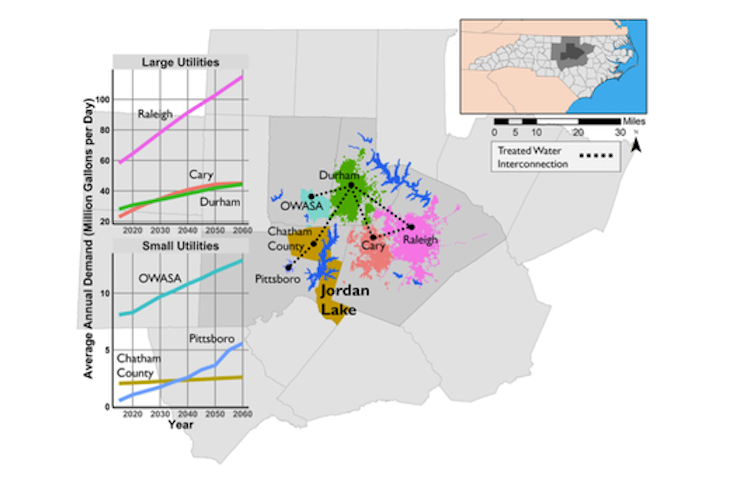Cooperation rewards water utilities
May 25, 2022
Mark Twain is attributed with the quote, “Whisky is for drinking, and water is for fighting over!” But what if, when it comes to urban water utilities, cooperation yields more benefits than going it alone?
A new study of water supply in the North Carolina Research Triangle found that agreements between water utilities can help mitigate their risks.
The research used supercomputer allocations on the Stampede2 system of the Texas Advanced Computing Center, which were awarded by the Extreme Science and Engineering Discovery Environment (XSEDE), funded by the National Science Foundation.
The findings are generalizable to any place where water providers allocate regional water resources among users that face challenges in supply and demand and in affordably financing infrastructure improvements.

Dr. David Gorelick
“We found that cooperation amongst utilities could be beneficial to both their water supply and financial needs compared to more traditional independent planning and management,” said David Gorelick, PhD, a postdoctoral research associate at the University of North Carolina at Chapel Hill. Gorelick works with the Center on Financial Risk in Environmental Systems in the Department of Environmental Sciences and Engineering at the UNC Gillings School of Global Public Health.
The study was published March 2022 in Water Resources Research, a journal of the American Geophysical Union.

Dr. Gregory Characklis
The four co-authors, including senior author Gregory Characklis, PhD — W. R. Kenan Jr. Distinguished Professor of environmental sciences and engineering at the Gillings School and director of the UNC Center on Financial Risk in Environmental Systems — began their research with a computational model they developed in collaboration with regional utilities in North Carolina.
“Their participation gives us a lot of confidence that our results will be used to inform their behavior and help avoid significant pitfalls when it comes to making long term, hundred-million-dollar financial decisions concerning water infrastructure, like new reservoirs or wastewater treatment plants,” said Gorelick, the lead author of the study.
The model simulates risk management and long-term infrastructure planning decisions out until 2060.
To achieve this result, the researchers evaluated the water supply system of the North Carolina Research Triangle. The area is home to about two million residents and is bounded by Chapel Hill, Durham and Raleigh. By simulating millions of possible ‘future states’ out to 2060, they honed in on water management strategies that remain robust in the face of a broad set of potential conditions.
“This work would not be possible without XSEDE supercomputing resources,” said study co-author David Gold, a doctoral candidate in the Department of Civil and Environmental Engineering at Cornell University. “Without supercomputing capabilities, we’d be flying blind in terms of how the water supply system reacts to different types of uncertainties, whether it’s population growth or changing climate. If we were to try to run these simulations on our desktops, it would take us more than 15 years to do all the simulations that we ran using Stampede2 over just the course of a few hours.”
A utility scale computational model of the region was thus developed using WaterPaths stochastic simulation software, which is a utility planning and management tool. The risk-of-failure was evolved based on reservoir capacity dynamics that change based on hydroclimatic conditions, human demands and decisions that combine weekly portfolio management with long-term annual infrastructure investments.
When it comes to utility providers working together, risks of inter-utility agreements include exposure to asymmetric partner growth or the inflexibility of the agreement structure itself to respond to evolving supply and demand. The study authors hypothesized that more flexible agreements might benefit partners more by allowing them to adapt to changing conditions.
“The study found that with less flexible agreements, utilities are limited to mitigating their own risks — they ultimately experienced more financial risk in these cases,” Gorelick said. “But when agreements can be updated over time, each utility is more exposed to the risks and the uncertainties of their partners. Overall, then, we found that cooperation is a good thing. But the manner in which cooperation occurs can be very important for water utilities, and it also affects the water rates all of us pay when we get our water bills.”

The study found that agreements between water utilities can help mitigate their risks, in research that used supercomputer simulations of the water supply for six population centers in the North Carolina Research Triangle. (Image credit: Gorelick et al.)
One agreement studied in the paper was a fixed allocation agreement, such as that for constructing a new reservoir or wastewater treatment plant. Because municipalities and local governments in the United States can enact inter-local agreements, utilities can partner together and be assigned fixed allocations of storage or treatment capacity in a shared project at the outset.
If one utility, for instance, pays for 20% of the development of that plant, they are allowed to use 20% of its capacity.
“Why these sorts of agreements matter, and why we wanted to test at least a couple in this study, is that the agreements are widespread and very customizable from place to place,” Gorelick explained.
To date, there have been few research efforts to assess how fixed allocation agreements perform in terms of utility supply and financial objects.
“Today, our water systems face greater challenges than ever. But, we also have tools that we’ve never had before, in terms of supercomputers,” Gold said. “When we think about the challenges and uncertainties stemming from population growth and changing climate, these computer resources allow us insight into the potential effects of such changes and provide the support we need to develop sustainable management strategies that can keep our water supply reliable for years to come.”
The study, “Impact of Inter-Utility Agreements on Cooperative Regional Water Infrastructure Investment and Management Pathways,” was published March 2022 in the journal Water Resources Research. The study authors are David Gorelick, PhD, and Gregory Characklis, PhD, of the University of North Carolina at Chapel Hill; and David Gold and Patrick Reed, PhD, of Cornell University.
Contact the UNC Gillings School of Global Public Health communications team at sphcomm@unc.edu.
